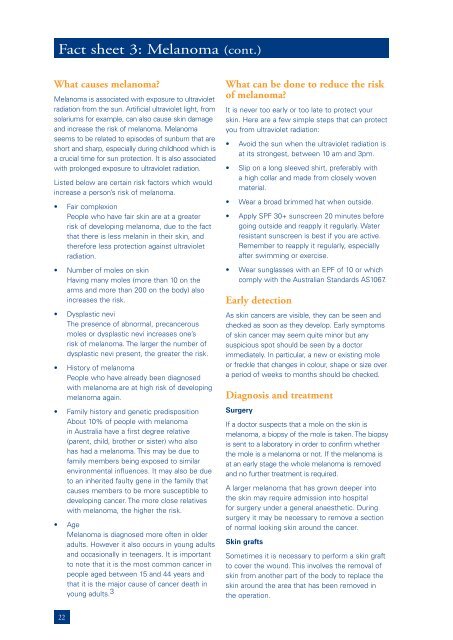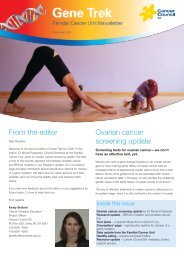Be SunSmart final print file.indd - Cancer Council SA
Be SunSmart final print file.indd - Cancer Council SA
Be SunSmart final print file.indd - Cancer Council SA
You also want an ePaper? Increase the reach of your titles
YUMPU automatically turns print PDFs into web optimized ePapers that Google loves.
What causes melanoma?<br />
Melanoma is associated with exposure to ultraviolet<br />
radiation from the sun. Artificial ultraviolet light, from<br />
solariums for example, can also cause skin damage<br />
and increase the risk of melanoma. Melanoma<br />
seems to be related to episodes of sunburn that are<br />
short and sharp, especially during childhood which is<br />
a crucial time for sun protection. It is also associated<br />
with prolonged exposure to ultraviolet radiation.<br />
Listed below are certain risk factors which would<br />
increase a person’s risk of melanoma.<br />
•<br />
•<br />
•<br />
•<br />
•<br />
•<br />
Fact sheet 3: Melanoma (cont.)<br />
22<br />
Fair complexion<br />
People who have fair skin are at a greater<br />
risk of developing melanoma, due to the fact<br />
that there is less melanin in their skin, and<br />
therefore less protection against ultraviolet<br />
radiation.<br />
Number of moles on skin<br />
Having many moles (more than 10 on the<br />
arms and more than 200 on the body) also<br />
increases the risk.<br />
Dysplastic nevi<br />
The presence of abnormal, precancerous<br />
moles or dysplastic nevi increases one’s<br />
risk of melanoma. The larger the number of<br />
dysplastic nevi present, the greater the risk.<br />
History of melanoma<br />
People who have already been diagnosed<br />
with melanoma are at high risk of developing<br />
melanoma again.<br />
Family history and genetic predisposition<br />
About 10% of people with melanoma<br />
in Australia have a first degree relative<br />
(parent, child, brother or sister) who also<br />
has had a melanoma. This may be due to<br />
family members being exposed to similar<br />
environmental influences. It may also be due<br />
to an inherited faulty gene in the family that<br />
causes members to be more susceptible to<br />
developing cancer. The more close relatives<br />
with melanoma, the higher the risk.<br />
Age<br />
Melanoma is diagnosed more often in older<br />
adults. However it also occurs in young adults<br />
and occasionally in teenagers. It is important<br />
to note that it is the most common cancer in<br />
people aged between 15 and 44 years and<br />
that it is the major cause of cancer death in<br />
young adults. 3<br />
What can be done to reduce the risk<br />
of melanoma?<br />
It is never too early or too late to protect your<br />
skin. Here are a few simple steps that can protect<br />
you from ultraviolet radiation:<br />
•<br />
•<br />
•<br />
•<br />
•<br />
Avoid the sun when the ultraviolet radiation is<br />
at its strongest, between 10 am and 3pm.<br />
Slip on a long sleeved shirt, preferably with<br />
a high collar and made from closely woven<br />
material.<br />
Wear a broad brimmed hat when outside.<br />
Apply SPF 30+ sunscreen 20 minutes before<br />
going outside and reapply it regularly. Water<br />
resistant sunscreen is best if you are active.<br />
Remember to reapply it regularly, especially<br />
after swimming or exercise.<br />
Wear sunglasses with an EPF of 10 or which<br />
comply with the Australian Standards AS1067.<br />
Early detection<br />
As skin cancers are visible, they can be seen and<br />
checked as soon as they develop. Early symptoms<br />
of skin cancer may seem quite minor but any<br />
suspicious spot should be seen by a doctor<br />
immediately. In particular, a new or existing mole<br />
or freckle that changes in colour, shape or size over<br />
a period of weeks to months should be checked.<br />
Diagnosis and treatment<br />
Surgery<br />
If a doctor suspects that a mole on the skin is<br />
melanoma, a biopsy of the mole is taken. The biopsy<br />
is sent to a laboratory in order to confirm whether<br />
the mole is a melanoma or not. If the melanoma is<br />
at an early stage the whole melanoma is removed<br />
and no further treatment is required.<br />
A larger melanoma that has grown deeper into<br />
the skin may require admission into hospital<br />
for surgery under a general anaesthetic. During<br />
surgery it may be necessary to remove a section<br />
of normal looking skin around the cancer.<br />
Skin grafts<br />
Sometimes it is necessary to perform a skin graft<br />
to cover the wound. This involves the removal of<br />
skin from another part of the body to replace the<br />
skin around the area that has been removed in<br />
the operation.



